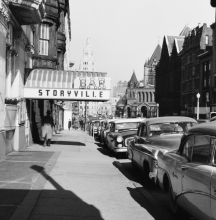(A note to readers: if any member of the Woke-Jazz-Patrol is offended by my use of the “D” word, please note it is historically accurate here — this band is announced as playing “Dixieland” by Nat Hentoff, a most energetic spokesman for all kinds of humane equality. So please fuss elsewhere. You’ll miss out on some good music while you’re fussing.)
The greatest artists are often most adaptable to circumstances, while remaining themselves. No working musician I know can afford much aesthetic snobbery, so if Monday you are playing with your working band, and Tuesday is a Balkan wedding, and Wednesday an outdoor cocktail party . . . the checks or cash still work the same.
Roy Haynes, born March 13, 1925 — thus 96 this year — began his recording career with Luis Russell’s big band in 1945 and played many sessions as the chosen drummer for Lester Young, Bud Powell, and Charlie Parker. I don’t think we expect to find him soloing on ROYAL GARDEN BLUES. Yet he does.
What we have here is a half-hour broadcast from George Wein’s “Storyville” club in Boston, on February 22, 1952 — young Mister Haynes was not yet 26. The band is George Wein, piano; John Field, string bass; “an anonymous drummer’; George Brunis, the guest star; Ruby Braff, cornet; Al Drootin, clarinet.
Musically, this may take time to get used to: Brunis shows off, musically and comically, overshadowing the band at first. I don’t know if Roy was filling in for Marquis Foster or Buzzy Drootin — for the week or for the broadcast? Brunis fully identifies him at 16:52. Hentoff tells the story that just before the broadcast, Brunis told him, for reasons he explains on the air, “Turn the name around,” so he is announced as “Egroeg Sinurb,” not easy to do on the spot.
The repertoire is standard, but the band enters into it with vigor, as does Roy. TIN ROOF BLUES (intro, Hentoff, m.c.) / MUSKRAT RAMBLE / SOMEDAY SWEETHEART / ROYAL GARDEN BLUES (Haynes solo) / UGLY CHILD (Brunis, vocal) / HIGH SOCIETY / TIN ROOF BLUES //
Lively music, and no one cares what name it’s called. No doubt it was just a gig, but it sounds like a fun one. And how nice it is that both George Wein (born October 3, 1925) and Roy are still with us.
May your happiness increase!





